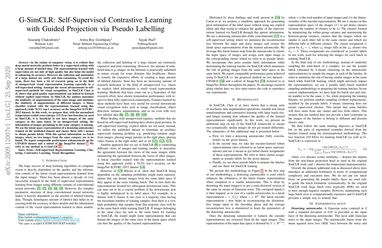G-SimCLR: Self-Supervised Contrastive Learning with Guided Projection via Pseudo Labelling

In the realms of computer vision, it is evident that deep neural networks perform better in a supervised setting with a large amount of labeled data. The representations learned with supervision are not only of high quality but also helps the model in enhancing its accuracy...
However, the collection and annotation of a large dataset are costly and time-consuming. To avoid the same, there has been a lot of research going on in the field of unsupervised visual representation learning especially in a self-supervised setting. Amongst the recent advancements in self-supervised methods for visual recognition, in SimCLR Chen et al. shows that good quality representations can indeed be learned without explicit supervision. In SimCLR, the authors maximize the similarity of augmentations of the same image and minimize the similarity of augmentations of different images. A linear classifier trained with the representations learned using this approach yields 76.5% top-1 accuracy on the ImageNet ILSVRC-2012 dataset. In this work, we propose that, with the normalized temperature-scaled cross-entropy (NT-Xent) loss function (as used in SimCLR), it is beneficial to not have images of the same category in the same batch. In an unsupervised setting, the information of images pertaining